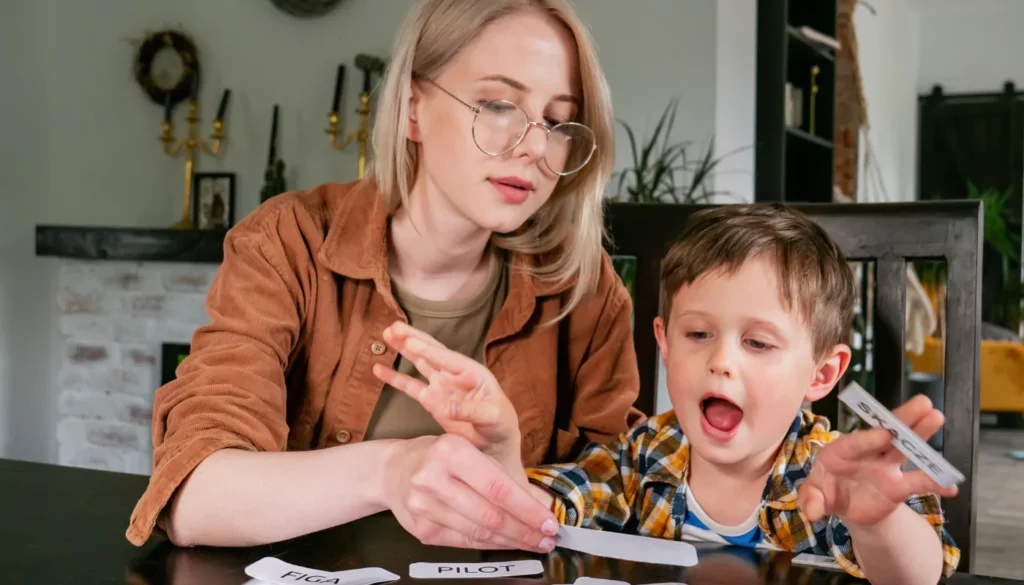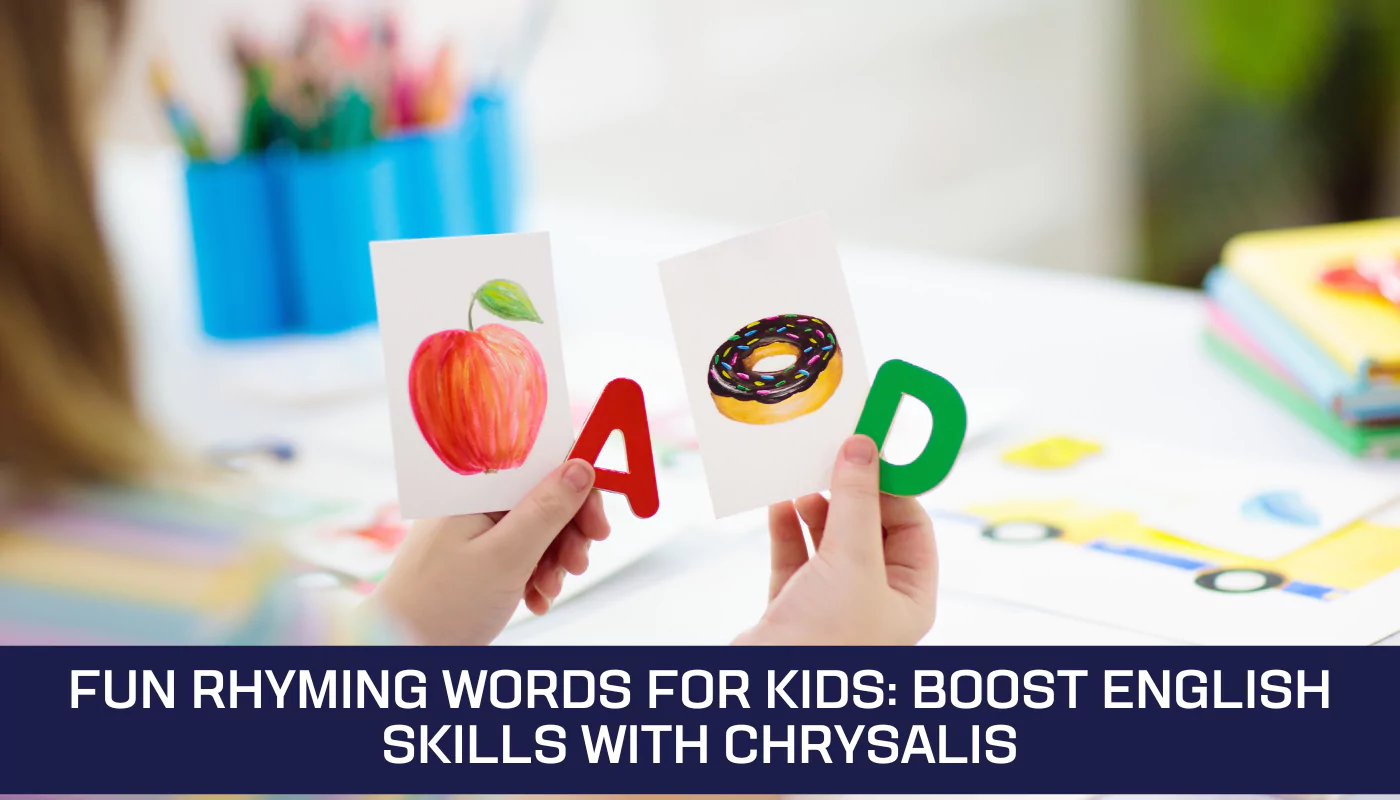Finding fun ways to teach English can be hard. Rhyming words are key for kids learning English. This article will show you how to make rhyming words exciting for kids. Let’s jump in!
Key Takeaways
- Rhyming words help kids learn English sounds and improve early literacy skills. They can start with simple one-syllable rhymes, like “cat” and “hat.”
- Games and activities, such as matching games or scavenger hunts, make learning rhymes exciting. These activities boost phonemic awareness.
- Creative writing with rhymes encourages kids to craft poems or songs. Drawing pictures paired with rhyming words also enhances memory and understanding.
- Reading rhyme-filled books during storytime helps children hear language sounds clearly. This improves their ability to recognize rhyme patterns.
- Using a variety of rhymes, from single to triple syllables, expands vocabulary and pronunciation skills while making learning playful and engaging.
Exploring Different Rhyming Words for Kids

| Single- Syllable Rhyming Words |
| Cat | Had | Sit | Pin | Cap | Ten |
| Bat | Mad | Hit | Tin | Map | Hen |
| Hat | Bad | Pit | Kin | Tap | Pen |
| Mat | Sad | Kit | Sin | Rap | Glen |
| Sat | Dad | Wit | Fin | Nap | Wren |
| Fat | Add | Lit | Win | Lap | When |
| Pat | Lad | Bit | Inn | Gap | Then |
| Rat | Pad | Fit | Bin | Slap | Men |
| Two- Syllable Rhyming Words |
| Bubble, Trouble, Humble |
| Double, Couple, Stumble |
| Pickle, fickle, sickle |
| Liver, river, shiver, never |
| Swollen, pollen, fallen |
| Moonlit, emit, permit, outwit |
| Jungle, Struggle,Uncle |
| Rumble, Hustle, Puzzle |
| Crumble, Rubble, Muscle |
| Mumble, Buckle, Tumble |
Kids love sounds that match, and finding words that sound alike is like a game. From “cat” and “hat” to more complex ones like “exciting” and “inviting,” there’s a whole world of rhymes to explore.
Exploring Single Rhymes: Cat and Hat
Cat, hat, bat, and mat all share a fun thing. They rhyme. Single-syllable rhyming words like these are easy for kids to learn. They focus on sounds within words. This helps with vocabulary and saying words right.
It also makes reading easier to start.
These simple rhymes boost memory and understanding too. Learning them can be the first step in loving language arts. Now let’s discover double rhymes, where things get even more fun!
Discover Double Rhymes: Butter Meets Flutter
Moving on from single rhymes like “cat” and “hat,” let’s explore double rhymes. Double rhymes are great fun for kids. They make words dance together in a playful way. For example, “butter” meets “flutter.” These words sound nice and help kids learn how to rhyme.
Double rhymes often have two syllables. Some more examples include “clutter” and “mutter.” Playing with these pairs can improve vocabulary and pronunciation. Finding double rhymes encourages creativity too! Kids can use them in poems or songs.
Listening for these sounds helps with early literacy skills as well.
Dive Into Triple Rhymes: Exciting, Inviting, Delighting
Triple rhymes are fun and playful. They can be exciting, inviting, and delighting. Words like “exciting,” “inviting,” and “delighting” share similar sounds at the end. This pattern helps kids learn about sounds in words.
It promotes early literacy skills too.
Using triple rhymes in creative writing enhances vocabulary. Kids can craft poems or songs easily with these terms. Rhyming dictionaries or rhyme finders are great tools to explore more options.
Discovering irregular plural forms and compound words adds even more fun to learning!
Interactive Rhyming Word Games for Kids

Interactive rhyming games are a blast for kids. They can match words and play fun activities that spark their imagination.
Match Rhyming Words with Fun Games
Matching rhyming words with fun games can spark joy in learning. Games like “Rhyme Time” let kids pair words that sound alike. Kids search for pairs like “cat” and “hat.” This builds their phonemic awareness.
It helps them hear sounds in words clearly.
Board games or online rhyme finders add excitement too. Children can explore a rhyming dictionary together. They enjoy competing to see who finds the most matching pairs. These activities make learning early literacy skills playful and engaging!
Enjoy Storytime with Books Full of Rhymes
Storytime can be a delight with books full of rhymes. Rhyming words help kids hear sounds in language. This skill builds phonemic awareness and boosts early literacy skills. Books like “The Cat in the Hat” or popular nursery rhymes make learning fun.
Children love to recite these rhythmic tales.
As they read, kids focus on rhyme patterns and memory retention. They enjoy the beat of words, making stories come alive! Engaging with rhymes encourages creative writing too. Kids might then want to create their own funny poems or songs using what they’ve learned about end rhymes and masculine rhymes.
Next up? Let’s explore some interactive games that will keep those rhyming juices flowing!
Go on a Rhyming Word Scavenger Hunt
A rhyming word scavenger hunt is a fun way to learn. Kids can search for items that rhyme. For example, they might find a cat and a hat or a mouse and a house. This game helps them spot rhyming words in their surroundings.
As children play, they boost phonemic awareness. They start to understand language sounds better. You can use books or even create your own lists of rhymes for the hunt. This exciting activity makes learning engaging and enjoyable!
Creative Uses for Rhyming Words in Learning

Rhyming words can make learning enjoyable! Kids can write silly poems or catchy songs using rhymes. They can also draw pictures that complement their rhyming pairs. This helps them remember the words better.
You’ll be surprised at what they create! Want to ignite your child’s creativity? Keep reading for exciting ideas!
Craft Poems or Songs with Rhyming Words
Crafting poems or songs with rhyming words can be fun. Kids enjoy making silly phrases and catchy tunes. Use simple rhymes like “cat” and “hat.” These words help kids focus on sounds.
This boosts their phonemic awareness and early literacy skills.
Encourage children to create short verses together. They can use a rhyming dictionary to find new pairs. Words like “butter” and “flutter” work well in playful lines. Let them illustrate their stories using these rhyme patterns too! Such creative writing helps improve reading comprehension while being enjoyable.
Illustrate Stories with Rhyming Word Pairs
Using rhyming word pairs can make stories more enjoyable. Kids love the sound of words that rhyme. Pairing words like “cat” and “hat” adds a playful touch to any tale. It captures attention and keeps listeners engaged.
Rhymes help children recall the story better too.
Try drawing pictures that match the rhyming pairs. For example, if you have “ball” and “mall,” illustrate both items together. This helps kids connect images with sounds. Using rhymes in storytelling enhances creativity as well.
Let your imagination run free with these word games!
Conclusion
Rhyming words are a blast! They make learning fun and easy for kids. Use them in games, songs, and stories. This helps with sounds and words. So grab a list of rhymes today. Let the fun begin!
FAQs
1. What are rhyming words and how can they engage kids in the English language?
Rhyming words, like those found in a rhyming dictionary or rhyme finder, are pairs or groups of words that have the same ending sound. They’re fun for children because they turn language into a game! They’re also great tools for creative writing and learning about things like masculine rhymes, feminine rhymes, double rhymes, and exact rhymes.
2. How can understanding rhyme patterns help with English-language arts?
Understanding rhyme patterns not only helps with creative writing but also plays an important role in English-language arts. It aids in understanding nursery rhymes and poems (like “The Raven”), recognizing singular and plural nouns, identifying stressed or unstressed syllables, using possessive pronouns correctly and even cracking puns!
3. Can mastering rime couée or tail rhyme assist kids during exams?
Absolutely! Mastering more complex forms of rhyme such as rime couée (a type of tail rhyme) can give students an edge on their English exams. By showing that they understand these advanced concepts from the common core curriculum – it demonstrates their grasp on figurative language.
4. Why should I encourage my child to learn about digraphs through rhyming words?
Digraphs – two letters producing one sound – often appear at the end of many commonly used English words making them perfect candidates for creating lists of easy-to-remember masculine or feminine exact-rhyme pairs.
5. Is there any connection between learning about verbs through rhyming words and becoming a rapper later on?
Well, you never know! Many successful rappers started out by playing around with simple word games like finding double-rhymes or using a rhyme-finder tool to come up with catchy lyrics!
6. Are there any resources available online to help my kid learn more about this topic?
Many websites offer free resources for parents and teachers, including lists of rhyming words, online rhyme-finders, interactive games involving plural nouns or verbs. These tools are designed to make learning fun and engaging for kids!

